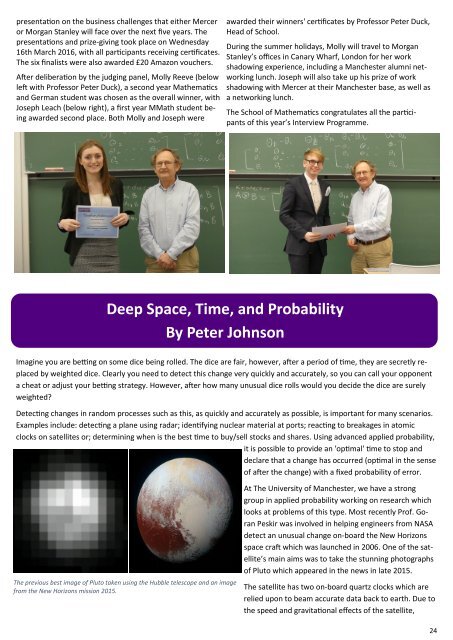Alumni Newsletter
June-2016-Alumni-Newsletter
June-2016-Alumni-Newsletter
You also want an ePaper? Increase the reach of your titles
YUMPU automatically turns print PDFs into web optimized ePapers that Google loves.
presentation on the business challenges that either Mercer<br />
or Morgan Stanley will face over the next five years. The<br />
presentations and prize-giving took place on Wednesday<br />
16th March 2016, with all participants receiving certificates.<br />
The six finalists were also awarded £20 Amazon vouchers.<br />
2016 Interview Programme Head of School. winners announced<br />
After deliberation by the judging panel, Molly Reeve (below<br />
left with Professor Peter Duck), a second year Mathematics<br />
and German student was chosen as the overall winner, with<br />
Joseph Leach (below right), a first year MMath student being<br />
awarded second place. Both Molly and Joseph were<br />
awarded their winners' certificates by Professor Peter Duck,<br />
During the summer holidays, Molly will travel to Morgan<br />
Stanley’s offices in Canary Wharf, London for her work<br />
shadowing experience, including a Manchester alumni networking<br />
lunch. Joseph will also take up his prize of work<br />
shadowing with Mercer at their Manchester base, as well as<br />
a networking lunch.<br />
The School of Mathematics congratulates all the participants<br />
of this year’s Interview Programme.<br />
Deep Space, Time, and Probability<br />
By Peter Johnson<br />
Imagine you are betting on some dice being rolled. The dice are fair, however, after a period of time, they are secretly replaced<br />
by weighted dice. Clearly you need to detect this change very quickly and accurately, so you can call your opponent<br />
a cheat or adjust your betting strategy. However, after how many unusual dice rolls would you decide the dice are surely<br />
weighted?<br />
Detecting changes in random processes such as this, as quickly and accurately as possible, is important for many scenarios.<br />
Examples include: detecting a plane using radar; identifying nuclear material at ports; reacting to breakages in atomic<br />
clocks on satellites or; determining when is the best time to buy/sell stocks and shares. Using advanced applied probability,<br />
it is possible to provide an 'optimal' time to stop and<br />
declare that a change has occurred (optimal in the sense<br />
of after the change) with a fixed probability of error.<br />
The previous best image of Pluto taken using the Hubble telescope and an image<br />
from the New Horizons mission 2015.<br />
At The University of Manchester, we have a strong<br />
group in applied probability working on research which<br />
looks at problems of this type. Most recently Prof. Goran<br />
Peskir was involved in helping engineers from NASA<br />
detect an unusual change on-board the New Horizons<br />
space craft which was launched in 2006. One of the satellite’s<br />
main aims was to take the stunning photographs<br />
of Pluto which appeared in the news in late 2015.<br />
The satellite has two on-board quartz clocks which are<br />
relied upon to beam accurate data back to earth. Due to<br />
the speed and gravitational effects of the satellite,<br />
24


